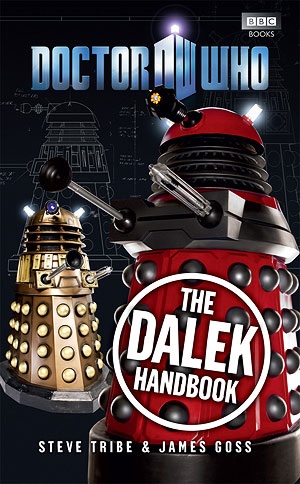BLOG The Dalek Handbook
None
SFX Blogger Alasdair Stuart is impressed by this history of the Daleks

Written by Steve Tribe and James Goss
Published by BBC Books
Doctor Who as a series is full of iconic images; the mad man with a Police Box, the scarf, the hat, the umbrella with a question mark on the end, the implacable Toby Jugs of death that are the Cybermen. Like them or loathe them, the Daleks are top of that list, one of the most instantly recognisable elements of the series and a common thread through every iteration of it, from comics to books to audio and TV. The Daleks and the Doctor have a lot of history together and Steve Tribe and James Goss have taken on the unenviable task of making sense of it all. They've succeeded too.
The Dalek Handbook is really two books for the price of one. The first is the detailed story of how the Daleks were produced and the constant challenges of trying to make a massive army of cybernetic death machines when you don’t actually have any more than three working models of them. This is fascinating and, often, very funny to read, and the special effects team on the show emerge as some of the great unsung heroes of 20th century science fiction. Richard Martin’s idea in the 1965 story “The Chase” of a “Dalek Merry Go-Round” is a perfect example. A Dalek would enter through one door, move off shot and then be frantically peddled around to the same door to emerge as a different Dalek. Three become dozens, as the Spice Girls could have sung, but thankfully never did. It’s not the only stroke of genius either, with Dalek toys being used for distance shots and, famously, “Destiny Of The Daleks” featuring one-sided partial Daleks that had to be carried through the countryside by extras. This made them appear to hop and whilst the concept of a bouncing Dalek is a little terrifying, it thankfully never caught on.
There are other details too, including tantalising sketches of the planned Spider Daleks for one of the numerous iterations of the “Doctor Who” TV movie and some welcome extra information. The plan was apparently to have the Daleks' casing become mission-adaptable, reconfiguring for everything from combat to flight. Intriguingly, the mutant within would also be able to leave, re-designed as a bipedal humanoid almost as deadly outside the suit as within it. It's an interesting idea, and it's particularly interesting to see that the mission-adaptable armour concept has been quietly adopted by the new breed of Daleks introduced in New Who series five.
Whilst all this technical stuff is fascinating, Tribe and Goss really shine when they start talking about the Daleks' torturous history. Every TV appearance, comic and audio appearance is here, and when laid out like this you get an idea of exactly how coherent the Dalek stories of both the old and new series are. Each time the Daleks are defeated they go back, regroup and try something new and things that work are kept and built upon. It's also interesting to see the concept of genetic adaptability, which would lead to the pseudo-human Daleks of “Bad Wolf” and “The Parting of the Ways” was introduced much earlier in the series, as was the Daleks' zealotry over their genetic purity. This really gives you a better insight into them as an alien race, less shouting, belligerent pepper pots and more reasoned, brutal, relentless warriors. They feel like a threat again by the end of this book and for someone who was starting to suffer Dalek fatigue, that’s a huge relief.
Sign up to the SFX Newsletter
Get sneak previews, exclusive competitions and details of special events each month!
Crammed with information, illustrations and a particularly wonderful comparison chart of every type of Dalek to date, this is a labour of love and a welcome companion to The TARDIS Handbook . One of the best BBC Who books so far.


